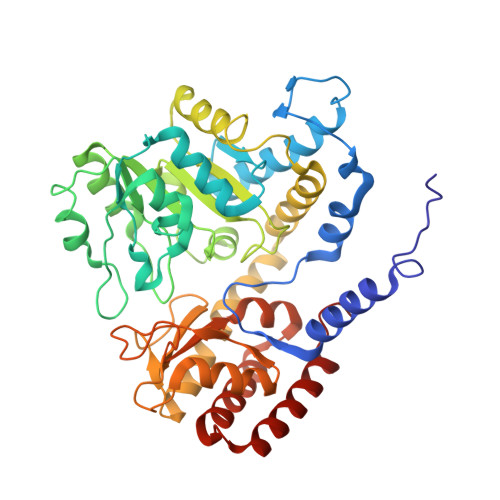Role of a conserved active site cation-pi interaction in Escherichia coli serine hydroxymethyltransferase.
Vivoli, M., Angelucci, F., Ilari, A., Morea, V., Angelaccio, S., di Salvo, M.L., Contestabile, R.(2009) Biochemistry 48: 12034-12046
- PubMed: 19883126
- DOI: https://doi.org/10.1021/bi901568b
- Primary Citation of Related Structures:
3G8M - PubMed Abstract:
Serine hydroxymethyltransferase is a pyridoxal 5'-phosphate-dependent enzyme that catalyzes the interconversion of serine and glycine using tetrahydropteroylglutamate as the one-carbon carrier. In all pyridoxal phosphate-dependent enzymes, amino acid substrates are bound and released through a transaldimination process, in which an internal aldimine and an external aldimine are interconverted via gem-diamine intermediates. Bioinformatic analyses of serine hydroxymethyltransferase sequences and structures showed the presence of two highly conserved residues, a tyrosine and an arginine, engaged in a cation-pi interaction. In Escherichia coli serine hydroxymethyltranferase, the hydroxyl group of this conserved tyrosine (Tyr55) is located in a position compatible with a role as hydrogen exchanger in the transaldimination reaction. Because of the location of Tyr55 at the active site, the enhancement of its acidic properties caused by the cation-pi interaction with Arg235, and the hydrogen bonds established by its hydroxyl group, a role of this residue as acid-base catalyst in the transaldimination process was envisaged. The role played by this cation-pi interaction in the E. coli serine hydroxymethyltransferase was investigated by crystallography and site-directed mutagenesis using Y55F and three R235 mutant forms. The crystal structure of the Y55F mutant suggests that the presence of Tyr55 is indispensable for a correct positioning of the cofactor and for the maintenance of the structure of several loops involved in substrate and cofactor binding. The kinetic properties of all mutant enzymes are profoundly altered. Substrate binding and rapid kinetic experiments showed that both Y55 and R235 are required for a correct progress of the transaldimination reaction.
- Dipartimento di Scienze Biochimiche and Istituto Pasteur, Fondazione Cenci Bolognetti, Sapienza Università di Roma, Piazzale Aldo Moro, 5-00185 Roma, Italy.
Organizational Affiliation:

















